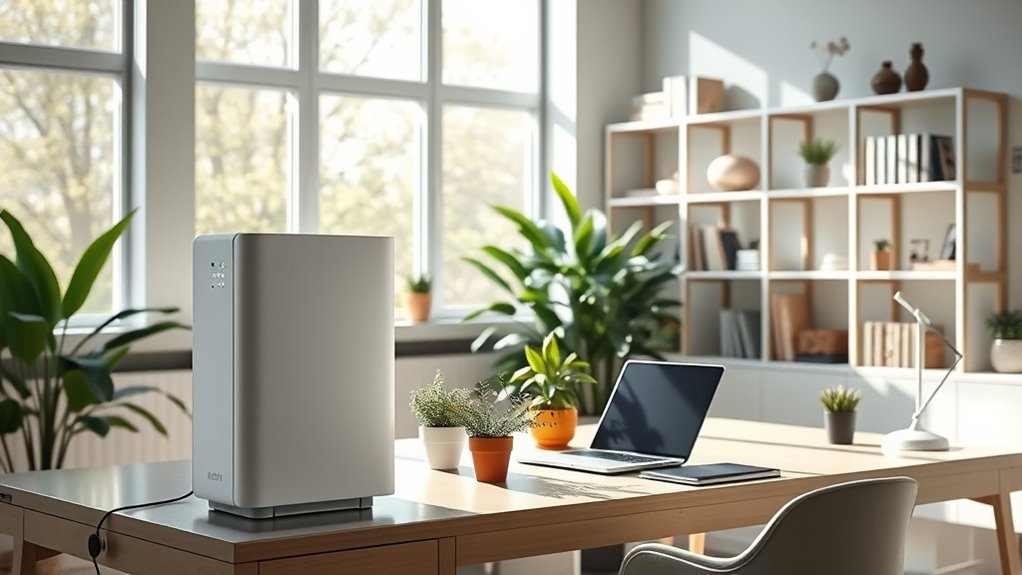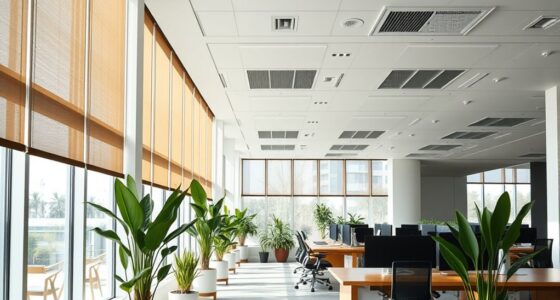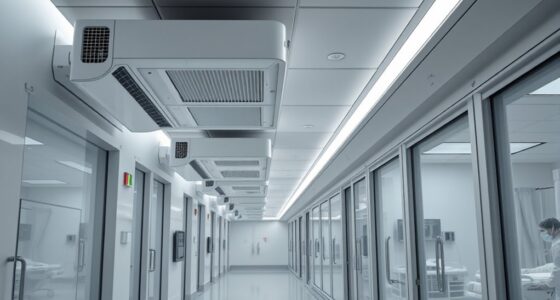To create a healthy workspace, focus on improving your air quality with indoor plants like snake plants and peace lilies, which naturally filter pollutants and increase oxygen. Regularly ventilate your space by opening windows or using air purifiers to reduce airborne allergens. Maintain proper humidity levels with humidifiers or dehumidifiers, and minimize clutter to prevent dust buildup. These strategies work together to boost your comfort and productivity—learn more tips to optimize your home office environment.
Key Takeaways
- Incorporate indoor plants like snake plants and peace lilies to naturally filter pollutants and boost air quality.
- Ensure proper ventilation by regularly opening windows and using air purifiers to circulate fresh air.
- Maintain optimal humidity levels with humidifiers or dehumidifiers to prevent respiratory discomfort and mold growth.
- Use high-quality air filters in HVAC systems and minimize dust and clutter to reduce airborne allergens.
- Avoid indoor smoking and VOCs from paints or cleaning supplies to prevent chemical pollutants from affecting health.

Have you ever considered how indoor air quality affects your productivity and health in your home office? The truth is, the air you breathe directly impacts your focus, energy levels, and overall well-being. Poor air quality can lead to headaches, fatigue, allergies, and even respiratory issues, making it harder to stay sharp and motivated throughout your workday. Fortunately, there are simple yet effective ways to improve your indoor environment, starting with incorporating indoor plants into your space.
Improving indoor air quality boosts your focus, health, and overall productivity in your home office.
Indoor plants are more than just decorative elements; they act as natural air purifiers. Certain plants, like snake plants, peace lilies, and pothos, have been shown to filter out common indoor pollutants such as formaldehyde, benzene, and trichloroethylene. These toxins can originate from furniture, cleaning products, and building materials, gradually degrading your indoor air quality. When you introduce indoor plants, you’re not only adding aesthetic value to your workspace but also actively improving the air you breathe. They absorb carbon dioxide and release oxygen, creating a fresher, more oxygen-rich environment that can boost your concentration and mental clarity.
Maintaining good air quality involves more than just adding plants; it also requires proper ventilation. Regularly opening windows or using air purifiers helps circulate fresh air and removes stale, polluted air. When combined with indoor plants, this creates a synergistic effect—plants can handle certain pollutants, but fresh air exchange is essential for overall air quality. Additionally, avoid clutter and dust accumulation, as these can trap allergens and irritants that compromise your indoor air. Using high-quality air filters in your HVAC system further reduces airborne particles, ensuring you breathe cleaner air throughout the day.
It’s also important to be mindful of indoor humidity levels. Dry air can cause respiratory discomfort, while overly humid environments encourage mold growth, both of which negatively affect air quality. Using a humidifier or dehumidifier helps maintain ideal humidity, making the air more comfortable and healthier to breathe. Avoid smoking indoors and minimize the use of volatile organic compounds (VOCs) from paints or cleaning supplies, as these can greatly deteriorate your indoor air quality. Incorporating air purification strategies can further optimize your environment by actively removing airborne pollutants.
Creating a healthy workspace isn’t just about ergonomic furniture or organization; it’s about ensuring the air around you supports your health and productivity. By integrating indoor plants, maintaining proper ventilation, and controlling humidity, you actively enhance your air quality. This investment in your environment pays off through increased focus, better health, and a more inviting home office atmosphere. Remember, the air you breathe is essential—make it as clean and fresh as possible to thrive in your daily work routine.
Frequently Asked Questions
What Are the Best Air Purifiers for Small Home Office Spaces?
You should choose an air purifier with advanced technology like HEPA filters and activated carbon to effectively eliminate dust, allergens, and odors in your small home office. Portable air filters are ideal because they’re compact and easy to move around. Look for models with quiet operation and energy efficiency to keep your workspace healthy without disruption. These features guarantee you breathe cleaner air while working comfortably.
How Often Should I Replace Filters in My Air Purifier?
You should replace your air purifier filters every 6 to 12 months, depending on usage. Did you know that poor air quality can impact productivity by up to 50%? Check your filter lifespan regularly and follow your unit’s recommended replacement schedule to guarantee peak performance. Neglecting timely replacements can reduce filtration efficiency and compromise your home’s air quality, so set reminders to keep your workspace fresh and healthy.
Do Air Purifiers Effectively Remove All Indoor Allergens?
Air purifiers with HEPA filters are highly effective at removing most indoor allergens like dust, pollen, and pet dander, but they might not eliminate all VOCs or airborne chemicals. While they considerably improve air quality, no purifier can remove 100% of all allergens or VOCs. For the best results, choose a model with HEPA filters and VOC removal capabilities, and maintain it regularly to keep your indoor air as clean as possible.
Can Air Purifiers Reduce Indoor Virus Transmission?
Yes, air purifiers can reduce indoor virus transmission. Their virus filtration relies on advanced air purifier technology like HEPA filters, which trap airborne viruses effectively. By continuously circulating and cleaning the air, you lower the risk of virus spread in your home office. Make sure to choose an air purifier with proper virus filtration capabilities and keep it running consistently for peak protection.
Are There Silent Air Purifiers Suitable for a Home Office?
Imagine working without distraction—like Sarah did when she chose the Winix Zero, a silent air purifier. It offers whisper quiet operation and an unobtrusive design, making it perfect for a home office. You won’t notice it working, but you’ll breathe cleaner air. This kind of purifier guarantees your workspace stays peaceful while effectively reducing pollutants, creating a healthier environment without noise interruptions.
Conclusion
Remember, a healthy home office starts with clean air. Investing in air purification not only improves your workspace’s freshness but also boosts your productivity and well-being. Don’t wait for problems to arise—prevention is better than cure. As the saying goes, “A stitch in time saves nine.” By taking action now, you create a safer, more comfortable environment where you can thrive and stay focused every day.










